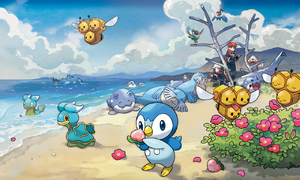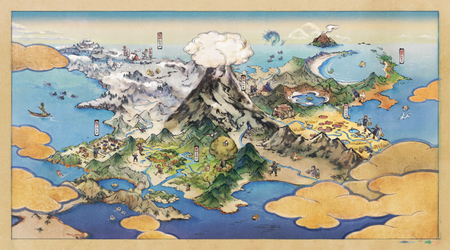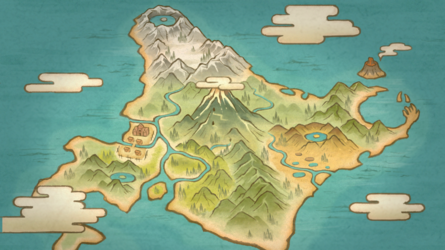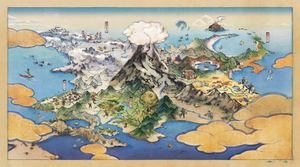Hisui: Difference between revisions
m (grammar) |
mNo edit summary Tag: Reverted |
||
| Line 39: | Line 39: | ||
The next humans to arrive in Hisui came from across the sea. The [[Diamond Clan|Diamond]] and [[Pearl Clan]]s took the name of the [[Celestica people]] as their own. These clans both worshiped a deity known as "almighty Sinnoh", with the Diamond Clan claiming it {{p|Dialga|created time}} and the Pearl Clan claiming it {{p|Palkia|created space}}. This disagreement set off a long-running feud between the two clans. Members of the clans also came to venerate the descendants of the ancient Noble and Ride Pokémon and appointed themselves as [[warden]]s to tend to their needs. | The next humans to arrive in Hisui came from across the sea. The [[Diamond Clan|Diamond]] and [[Pearl Clan]]s took the name of the [[Celestica people]] as their own. These clans both worshiped a deity known as "almighty Sinnoh", with the Diamond Clan claiming it {{p|Dialga|created time}} and the Pearl Clan claiming it {{p|Palkia|created space}}. This disagreement set off a long-running feud between the two clans. Members of the clans also came to venerate the descendants of the ancient Noble and Ride Pokémon and appointed themselves as [[warden]]s to tend to their needs. | ||
The latest arrivals in Hisui was the [[Galaxy Team|Galaxy Expedition Team]], | The latest arrivals in Hisui was the [[Galaxy Team|Galaxy Expedition Team]], comprising people from numerous other regions including [[Hoenn]], [[Alola]], and [[Galar]]. These settlers built [[Jubilife Village]] in Hisui's southwestern corner. The Galaxy Expedition Team had been assembled to evaluate Hisui's viability for settlers, and to that end it embarked on an ecological study of the island. A significant part of this study involved the creation of the first complete Hisuian [[Pokédex]] at the direction of [[Professor Laventon]]. Unlike the two clans that lived in Hisui prior, the people of Jubilife Village were distrusting of Pokémon. To capture and store Pokémon, the expedition team brought with them [[Poké Ball]]s, a newly-invented technology. Hisui plays a large part in the [[history of Poké Balls]]. | ||
{{spoilers}} | {{spoilers}} | ||
Revision as of 02:50, 28 April 2024
- If you were looking for the character from The Power of Us known as Hisui in Japanese, see Harriet.
| |||||||||||||||||||
|
| |||||||||||||||||||
| |||||||||||||||||||
| |||||||||||||||||||
| |||||||||||||||||||
| |||||||||||||||||||
The Hisui region (Japanese: ヒスイ地方 Hisui region) refers to Sinnoh as it was known during discovery and settlement, in a historical period set prior to Generation IV. It is the setting of Pokémon Legends: Arceus.
Etymology and design concept

Etymology
Hisui may be derived from 翡翠 hisui (jade) or 秘邃 hisui (hidden and profound), the latter of which matches Sinnoh's name origin.
Design concept
- Main article: Pokémon world in relation to the real world → Sinnoh
Hisui may be based on the Japanese island of Hokkaido while it was still known as Ezo, referring to its inhabitants prior to the Meiji Restoration. In 1869, the northern frontier was renamed to its current administrative title, which translates to northern sea circuit.
History
- Main article: Sinnoh → History
Human habitation of Hisui is estimated to have begun when Hisui was created, as said in myth.
According to Cogita, her ancestors, the Sinnoh people, lived in Hisui and worshiped Arceus one or two millennia before the events of Pokémon Legends: Arceus. A legend states that an ancient hero befriended ten Pokémon, who had received Arceus's blessing, and gathered the Plates in order to find Arceus. These ten Pokémon would eventually have descendants known as Hisui's five Noble and Ride Pokémon.
The next humans to arrive in Hisui came from across the sea. The Diamond and Pearl Clans took the name of the Celestica people as their own. These clans both worshiped a deity known as "almighty Sinnoh", with the Diamond Clan claiming it created time and the Pearl Clan claiming it created space. This disagreement set off a long-running feud between the two clans. Members of the clans also came to venerate the descendants of the ancient Noble and Ride Pokémon and appointed themselves as wardens to tend to their needs.
The latest arrivals in Hisui was the Galaxy Expedition Team, comprising people from numerous other regions including Hoenn, Alola, and Galar. These settlers built Jubilife Village in Hisui's southwestern corner. The Galaxy Expedition Team had been assembled to evaluate Hisui's viability for settlers, and to that end it embarked on an ecological study of the island. A significant part of this study involved the creation of the first complete Hisuian Pokédex at the direction of Professor Laventon. Unlike the two clans that lived in Hisui prior, the people of Jubilife Village were distrusting of Pokémon. To capture and store Pokémon, the expedition team brought with them Poké Balls, a newly-invented technology. Hisui plays a large part in the history of Poké Balls.
Two years after the establishment of Jubilife Village, a space-time rift appeared above Mount Coronet, and causes several distortions and storms. Lighting from the rift had struck the four Noble Pokémon that the two clans take care for. During this time, a strange visitor had fallen from the sky. This character, serving as the player in Legends: Arceus, is found by Professor Laventon at Jubilife's Prelude Beach, and is offered to work for the Galaxy Team after they have shown Laventon their skill. After given some test by the player's friend, known as either Rei or Akari, Captain Cyllene of the Survey Corps appoints them as part of the team followed by Laventon providing them a first partner Pokémon.
The Diamond and Pearl Clans are immediate to go to the Galaxy Team after their Noble Pokémon have caused destruction to both themselves and the land of Hisui. The player character is then appointed to investigate the problems with these four Pokémon and quell their rage, on top of completing Hisui's first Pokédex. As they progress, the player teaches the people of Jubilife Village about Pokémon and companionship, as well allowing the Diamond and Pearl Clans to get along with not only each other, but with ideas from the Galaxy Team as well. The player quells all five Noble Pokémon, but soon, the sky turns red and the space-time distortions worsen, causing Kamado the Galaxy Team's leader, to distrust the player in assumption they were a part of the cause. The player is kicked out from the team and is no longer allowed within Jubilife Village, seeking help from either clan, who are unable to provide assistance. Volo, a character who the player has met before, assists the player in their time of need and brings them to Cogita, telling them to seek the Lake guardians and form a Red Chain. Adaman and Irida, the Clan Leaders, assist the player in their journey to avoid any ill intentions with the Galaxy Team or their clans. They return to the Temple of Sinnoh that rests upon the top of Mount Coronet. After gaining the trust of the Galaxy team again, the player summons either Dialga or Palkia and gains their respect. The Legendary Pokémon warns their respective Clan leader about their counterpart, who immediately appears from a portal, in their Origin Forme. The raging counterpart destroys any remains of the Red Chain and the Temple of Sinnoh. The Clan Leaders, Professor Laventon, Rei/Akari and the player then set out to create a special Poké Ball, made of left over pieces of the Red Chain and Origin Ore and use it to quell the raging counterpart at the Temple of Sinnoh.
After their success, the player continues their attempt at finishing Hisui's Pokédex, where they are stopped by Volo who's in a search for the remaining Plates, on their search, many runes and scripts are left by the Celestica people, with a story similar to that of player. Given to the player by Hisui's Noble and Ride Pokémon, the remaining Plates are held by Hisui's other Legendary Pokémon. In success with capture, the player and Volo meet at Mount Coronet, and are told of a banished Pokémon who served as a third counterpart to Dialga and Palkia. At the now destroyed Temple of Sinnoh, who Volo claims look like spears sticking out of the ground, the player is found with conflict against the Pokémon wielder, betraying their trust in hopes to meet Arceus. Giratina is summoned by Volo after defeat and explains that it was cause of the space-time distortions had that appeared throughout Hisui, angering the Nobles and causing previous Origin Forme to go berserk. Once defeated, Volo claims he will continue to find Arceus for as long as it may take.
Hisui's first Pokédex is completed and the player returns to the Temple of Sinnoh, now with an Azure Flute in hand and summons Arceus at the Hall of Origin. Arceus gifts the player a piece of themselves, acting as the Arceus species and the final Pokémon in the Pokédex.
After the events of the main story, smaller events known Massive mass outbreaks start occurring throughout the region during rainstorms. The Galaxy Team and clans begin researching these odd phenomenon.
Between this time and the modern day, Hisui will become to be known as the Sinnoh region. The Galaxy Team plans to disband after their objectives have been met, though Cyllene intends to make sure the team's name is passed on.
Geography
Environment
- Main article: Sinnoh → Environment
The Hisui region, much like its modern day counterpart of Sinnoh, features a variety of terrains, whether it be rocky mountains, moist swamps or vast oceans, many of Sinnoh's visuals and weather are retained. Hisui's environment is much more abrasive and harsh, and due its more recent settlement, there is very little man-made activity with only one village and two other settlements. Activity is sprawling with more Pokémon than in the future, with many of them acting hostile.
Also like Sinnoh, Hisui is a large region that can be split up, usually between an Eastern and a Western half with Mount Coronet at its center. The location and environment will change the cloak that Burmy wears, and determine the form of Shellos and Gastrodon that are found. Unlike Sinnoh, the region is also split further than just the two halves, containing five separate sub-regions, often split into their own smaller environments. These sub-regions include: the Obsidian Fieldlands, the Crimson Mirelands, the Cobalt Coastlands, the Coronet Highlands and the Alabaster Icelands.
The Obsidian Fieldlands is the least hostile of the five sub-regions. The location, as its name suggests, features grassy plains with flower patches and forests that are surrounded by beaches and mountains at its ends. The Obsidian Fieldlands is located in the southwest of Sinnoh which would eventually become Sandgem Town and Route 201. The Obsidian Fieldlands is flat enough to ride Wyrdeer across the location. The fieldlands' meadows and terrain are split up between two rivers that lead from the north and into the south, ending into the ocean of Sandgem Flats and Ramanas Island. The more one follows the paths leading southeast, they'll be met with several hills in the center of location, and further more wooded areas containing The Heartwood. On the opposite side in the southwest is body of water known as Lake Verity.
The Crimson Mirelands, the location that would eventually become modern day Pastoria City, the Great Marsh and Solaceon Town, is entirely filled with swamps and rivers, and as its name suggest, plenty of red mud and soil. It is located in the southeastern end of the region. It has multiple ruins and inscriptions such as the Solaceon Ruins. Fog is often present in this the Mirelands. While still grassy, it is much more hilly and steep compared to that of the Obsidian Fieldlands. The swampy terrain of the Crimson Mirelands allows for peat to be found. The Diamond Settlement sit on the Northern end of the Crimson Mirelands, with Lake Valor resting beside it.
The Eastern side of Hisui are the beaches of the Cobalt Coastlands. These beaches would eventually become the Eastern side of Sinnoh, including Sunnyshore City and Valor Lakefront. These beaches are often rocky, and will require a way to get from one side to another such as the use of a Basculegion to ride on. Shaped like a crescent, the lowerhalf of the location reaches out to the east with a hand-shaped beach known as Sand's Reach. The location has several boxes and washed up trash from old cargo ships, allowing for Burmy to change into its Plant Cloak. On the upper half, divided by Veilstone Cape, is the Spring Path containing Hisui's fourth lake and Turnback Cave. The Cobalt Coastlands features volcanic activity in the form of Firespit Island, which much be traveled to by water.
The core of Hisui is the Coronet Highlands with its most defining features being the tall and rocky Coronet Mountain range with Mount Coronet at its heart. The highlands reaches high altitudes with very little roads, requiring the need of a Pokémon such as Sneasler to traverse its rocky slopes. The mountain range, and not limited to Mount Coronet or peaks, has a magnetic field that allows for Pokémon such as Nosepass to evolve. The mountains contain several pools of water, with one such spring, the Fabled Spring, to be where Clefairy gather under a full moon. Inside the mountain range are numerous caves and tunnels, including Wayward Cave. Multiple ruins from the Celestica People are found the higher one travels, ending at the snowy summit of Mount Coronet where the Temple of Sinnoh lies.
The most northern part of Hisui is the Alabaster Icelands. Like its modern day counterpart of Route 216, Route 217 and Snowpoint City, it is covered in snow. Like many parts of the region, the icelands are also incredibly rocky and mountainous, these rocky formations are often covered in thick-slippery ice that even Sneasler cannot climb. This is especially true in the southern ends of the location that connects to rocky locations of the Coronet Highlands, which like it, has some caves and tunnels. The Alabaster Icelands is mostly barren, but still contains vegetation and tall trees, as well as a river. There is multiple hot springs that one can visit. Many of these springs are found at the Pearl Settlement that rests at the cliffs below Snowpoint Temple. Above these cliffs is also Lake Acuity, containing a waterfall that leads to the river.
Climate
- Main article: Sinnoh → Climate
Hisui's climate contains many elements from its modern day, but also contains many differences from what one would otherwise expect. The Pokémon are not the only thing that is harsh, but as is the region's climate.
Each sub-region has its own sub-climate, with Hisui's going through its own seasonal changes. These changes are usually accompanied by the Forces of Nature. Like Sinnoh, the region is colder in temperature taking place farther north than other locations, allowing for people to dress more appropriately in bundled clothing. In Pokémon Legends: Arceus, the weather typically typically changes all on its own and random intervals. Each sub-region has its own sub-climate, with the Obsidian Fieldlands and Coronet Highlands having mostly clear skies; the Crimson Mirelands typically being more moist and damp, the Cobalt Coastlands often has rain showers and the Alabaster Icelands is known to have strong winds and snow. These weather conditions are not exclusive to the individual locations (aside from snow), but are more common amongst them.
In Daybreak a small story found in Legends Arceus, four of the five locations will have harsh rainstorms that causes Massive mass outbreaks to occur. In the Alabaster Icelands, which can't have rain, has strong snow storms instead.
Hisui is unique among other locations, in that it is known to carry space-time distortions when a space-time rift occurs over the head of Mount Coronet. These disturbances can appear throughout the entire region, and brings Pokémon, items and even people from alternate timelines or realities. Space-time distortions, along with the space-time rift, can create abnormal lightning, and other weather conditions may occur.
Ecology

Hisui's harsh environment and climate is much different from most regions of the modern day, leading to many Pokémon being uniquely found within the region as well. Many of which are also not found in the modern-day Sinnoh as well, implying that many of the Pokémon found in Hisui to have gone either extinct or migrate out of the region by the time the events of Pokémon Diamond and Pearl happen. For example, Wyrdeer are a species of Pokémon evolving from Stantler, a species that still exists in the modern day, but is not found in any of Sinnoh's Pokédexes, and its entry in the Paldea Pokédex for Pokémon Violet specifically state that it used to evolve, implying that Wydeer had gone fully extinct. While the Qwilfish in Hisui are known to have migrated to other colder climates instead, according to the Pokédex at Blueberry Academy. Hisui's conditions have brought forth many evolutions and regional forms that are not found else where in the world. Many of these changes are related to Hisui's seasonal and colder climates, having the Pokémon adapt to new forms. Laventon's study of Decidueye confirms that environment can be an influence on evolution, with the Pokémon in particular having to adapt to the cold. The regional forms first discovered in the Hisui region are described as Hisuian forms. Hisui is known to have Pokémon appear within outbreaks, having certain species appear in swarms and groups, appearing more frequently then they would usually.
Professor Laventon of the Galaxy Team is a Pokémon professor who studies the ecology of Pokémon, and is tasked by the Survey Corps to create Hisui's first Pokédex.
Hisui's vegetation is also an important part of the ecosystem and to the people and Pokémon who live there, with many plants growing only in Hisui and in no other locations. Similar to regional forms, Hisui also grows a unique type of Apricorn that other regions such as Johto and Galar may not, including Brown Apricorns. The many plants that can be used for food that grow in Hisui include Sand Radishes, Sootfoot Roots and many types of Berries. Many of the vegetation in the region is determined by sub-region, for example, Pop Pods are a sea vegetable that grow only in the Cobalt Coastlands, while Sand Radishes will only grow in the Alabaster Icelands.
Among usage in food and delicacy, the natural elements found in the region are also used for crafting, an important part of survival in the region. The usage of items are often used to to make other foods, but also items such as Poké Balls, and Potions. Balms for Noble Pokémon are often made with ingredients found from around the location that the normal variants of that species would prefer, such as Lord Electrode preferring food made from Crunchy Salt. This salt often grows in Hisui's mountain tops where Hisuian Electrode tend to live. Many materials are also harvested from the Pokémon themselves, especially plant-like or Poison-Type Pokémon such as Petilil, whose leaves are used for medical care, and Croagunk, whose toxins could be used for similar purposes. Medicinal Leeks are a common vegetable found through out the entire region, and are also used for basic medical purposes and healing. These herbs are often mixed into Potions, but can also be applied directly.
Demographics

|
This section is incomplete. Please feel free to edit this section to add missing information and complete it. |
Hisui has a total population of 111 people split up between the Galaxy Team, the Diamond Clan and the Pearl Clan, having the shortest population of people to date compared to other regions' introductions, as a result of Hisui being recently established. Many of the people originate from different regions from all over the world, including: Hoenn, Alola and Galar. The Celestica people, an ancient tribe of Hisuians, had originally lived in the region before dying out. Cogita and Volo are stated to be related to the Celestica people or other ancient tribes described as the ancient Sinnoh people.
Notable locations

Settlements
Additionally, some of the base camps are suggested to be turned into actual settlements. All five of the major sub-regions in Hisui have two base camps, except for the Coronet Highlands, which has three. These base camps are:
- Fieldlands Camp
- Heights Camp
- Mirelands Camp
- Bogbound Camp
- Beachside Camp
- Coastlands Camp
- Highlands Camp
- Mountain Camp
- Summit Camp
- Snowfields Camp
- Icepeak Camp
Landmarks
- Jubilife Village
- Obsidian Fieldlands
- Crimson Mirelands
- Cobalt Coastlands
- Coronet Highlands
- Alabaster Icelands
Appearance
Artwork

|

|
| Key art for Pokémon Legends: Arceus | Artwork of Hisui from Pokémon Legends: Arceus by You Iribi[1] |
In-game

|
| In game map from Pokémon Legends: Arceus |
Trivia
- The adjectival form of Hisui is "Hisuian", as seen in the term Hisuian Form.
- During the post-game of Pokémon Legends: Arceus, Kamado muses that Hisui could be called the Sinnoh region after the deities the Diamond and Pearl Clans worship, alluding to the region's present-day name.
- Aside from the Coronet Highlands, the names of the four main areas of Hisui correspond to the colors associated with the Chinese Four Symbols: the Black Tortoise of the North (Obsidian Fieldlands), the Vermilion Bird of the South (Crimson Mirelands), the Azure Dragon of the East (Cobalt Coastlands), and the White Tiger of the West (Alabaster Icelands). The locations for two of the main areas even correspond to the cardinal directions the Four Symbols represent: the Crimson Mirelands is located roughly in the south or southeast of Hisui, and the Cobalt Coastlands is located in the east of Hisui. The Forces of Nature will also start roaming each of the four areas on certain weather conditions, after the player receives the request "Incarnate Forces of Hisui".
In other languages
| Language | Name | Origin |
|---|---|---|
| German, Spanish, French, Italian, Indonesian, Portuguese |
Hisui | From its Japanese and English name |
| Korean | 히스이 Hiseui | Transcription of its Japanese name |
| Chinese (Mandarin) | 洗翠 Xǐcuì | Transcription of its Japanese name. Contains 翠 cuì (jade). |
| Chinese (Cantonese) | 洗翠 Sáicheui | Mandarin-based transcription of its Japanese name. Contains 翠 cheui (jade). |
| Hebrew | היסוי Hisui | Transcription of its English name |
| Russian | Гисуи Gisui | Transcription of its English name |
| Thai | ฮิซุย Hisui | Transcription of its Japanese name |
References
See also
| Regions in the Pokémon world | ||
|---|---|---|

|
This article is part of Project Locations, a Bulbapedia project that aims to write comprehensive articles on every location in the Pokémon world. |

